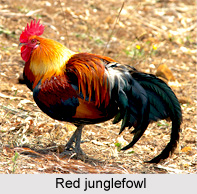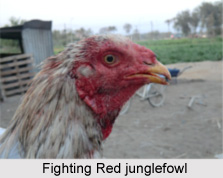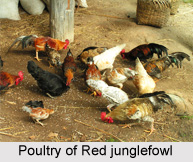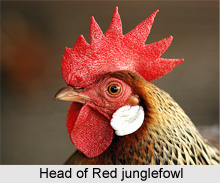
Red jungle fowl with a scientific name "Gallus gallus" is a tropical member of the Phasianidae family.
Domestication of Red Jungle Fowl
Red junglefowl was first domesticated at least five thousand years ago in Asia, then taken around the world, and the domestic form is kept globally as a very productive food source of both meat and eggs.
Concentration of Red Jungle Fowl
The range of the wild form of Red jungle fowl stretches from Tamil Nadu, South India (where it has almost certainly been diluted with cross breeding from domestic breeds), and eastwards across southern China and into Malaysia, Singapore, Philippines and Indonesia. Junglefowl are established on several of the Hawaiian Islands, including Kauai, but these are feral descendants of domestic chickens. They can also be found on Christmas Island, Vanuatu, and the Mariana Islands.

Genders of Red Jungle Fowl
The male and female species of Red jungle fowl birds show very strong sexual dimorphism. Males are much larger; they have large red fleshy wattles and comb on the head and long, bright gold and bronze feathers forming a "shawl" or "cape" over the back of the bird from the neck to the lower back. The tail is composed of long, arching feathers that initially look black but shimmer with blue, purple and green in good light. The female`s plumage is typical of this family of birds in being cryptic and having evolved for camouflage as she alone looks after the eggs and chicks. She also has no fleshy wattles or comb on the head.
 Mating of Red Jungle Fowl
Mating of Red Jungle Fowl
During their mating season, the male birds announce their presence with the well known "cock-a-doodle-doo" call or crowing. Male red jungle fowl have a shorter crowing sound than domestic roosters; the call cuts off abruptly at the end. This serves both to attract potential mates and to make other male birds in the area aware of the risk of fighting a breeding competitor. A spur on the lower leg just behind and above the foot serves in such fighting. Their call structure is complex and they have distinctive alarm calls for aerial and ground predators to which others react appropriately.
Behaviours of Red Jungle Fowl
The males make a food-related display called "tid-bitting", performed upon finding food in the presence of a female. The display is composed of coaxing, cluck-like calls and eye-catching bobbing and twitching motions of the head and neck. During the performance, the male repeatedly picks up and drops the food item with his beak. The display usually ends when the hen takes the food item either from the ground or directly from the male"s beak and is associated with copulations and more offspring. Males that produce anti-predator alarm calls appear to be preferred by females.

Foods of Red Jungle Fowl
Red jungle fowl are omnivorous and feed on insects, seeds and fruits including those that are cultivated such as those of the oil palm.
Habitats of Red Jungle Fowl
Red Jungle Fowl regularly bathe in dust to keep just the right balance in their plumage. The dust absorbs extra oil and subsequently falls off. The flight in these birds is almost purely confined to reaching their roosting areas at sunset in trees or any other high and relatively safe places free from ground predators, and for escape from immediate danger through the day.











